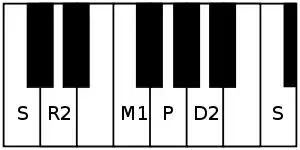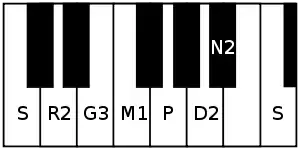Yadukulakamboji
Yadukulakamboji or Yadukulakambodi (yadukulakāmbhōji) is a rāgam in Carnatic music (musical scale of South Indian classical music). It is a janya rāgam (derived scale) from the 28th melakarta scale Harikambhoji, and is sometimes spelled as Yadukulakambhoji or Yadukulakambhodi. It is a janya scale, as it does not have all the seven swaras (musical notes) in the ascending scale. It is a combination of the pentatonic scale Shuddha Saveri and the sampurna raga scale Harikambhoji.[1][2]
| Arohanam | S R₂ M₁ P D₂ Ṡ |
|---|---|
| Avarohanam | Ṡ N₂ D₂ P M₁ G₃ R₂ S |
| Carnatic music |
|---|
 |
| Concepts |
| Compositions |
| Instruments |
|
Structure and Lakshana


Yadukulakamboji is an asymmetric rāgam that does not contain gandharam and nishadam in the ascending scale. It is an audava-sampurna rāgam (or owdava rāgam, meaning pentatonic ascending scale).[1][2] Its ārohaṇa-avarohaṇa structure (ascending and descending scale) is as follows:
- ārohaṇa : S R₂ M₁ P D₂ Ṡ[lower-alpha 1]
- avarohaṇa : Ṡ N₂ D₂ P M₁ G₃ R₂ S[lower-alpha 2]
The notes used in this scale are shadjam, chathusruthi rishabham, shuddha madhyamam, panchamam and chathusruthi dhaivatam in ascending scale, with kaisiki nishadham and antara gandharam included in descending scale. For the details of the notations and terms, see swaras in Carnatic music.
Popular compositions
There are many compositions set to Yadukula kamboji rāgam. Here are some popular kritis composed in this ragam.
- Kāmākṣhī padayugame sthiramaninē, by Shyama Shastri ( Very Famous svarajati)
- Hecharikaga ra rama, Ni Dayache Rama, etavuna nerchitivo, and Sri Rama Jayarama composed by Tyagaraja
- Divakara tanujam and Tyagarajam bhajare by Muthuswami Dikshitar
- Ikshvaku kula & Pahimam sri ramayante by Bhadrachala Ramadasu
- Mohanamayi and Bhujaga shayino by Swathi Thirunal Rama Varma
- Paramakripa sagari pahi parameshvari by G. N. Balasubramaniam
- Kalaith thookki nindradum by Marimutthu Pillai
- Anagha Shambho by Thulaseevanam
- sharade pahi mam by Mysore Vasudevacharya
- Padmanabham Bhajeham by Maharaja Jayachamarajendra Wadiyar
- Kumaran thal paninde by Papanasam Sivan
- Lalithe Mampahi Daya by Sri Chengalvaraya Sastri
- thondar anju by Thirugnanasambandar
- Yarendru Raghavanai by Arunachalakavi
- Kama Nishudanam Bhavaye by Tulasivanam
Film Songs
Language:Tamil
| Song | Movie | Composer | Singer |
|---|---|---|---|
| Kaasikku Pogum Sanyasi... | Chandhrodhayam | M. S. Viswanathan | T. M. Soundararajan, Sirkazhi Govindarajan |
| Adangoppuraane | Kaavalkaaran | T. M. Soundararajan | |
| Kalyana Valayosai | Urimaikural | T. M. Soundararajan,P. Susheela | |
| Vetri Vendumaa | Ethir Neechal | V. Kumar | Sirkazhi Govindarajan |
| Othaiyila | Vanaja Girija | Ilaiyaraaja | K. S. Chithra |
| Nalla Neram | Uthama Raasa | S. P. Balasubrahmanyam | |
| Singara Maane | Thai Mozhi | Mano, Swarnalatha | |
| Kuluvalilae | Muthu | A. R. Rahman | Udit Narayan, K. S. Chithra, Kalyani Menon, G. V. Prakash Kumar |
Related rāgams
This section covers the theoretical and scientific aspect of this rāgam.
Scale similarities
- Shuddha Saveri has a symmetric pentatonic scale, with the notes same as the ascending scale of Yadukulakamboji. Its ārohaṇa-avarohaṇa structure is S R₂ M₁ P D₂ Ṡ: Ṡ D₂ P M₁ R₂ S
- Kedaragaula is a rāgam which has the kaishiki nishadam in ascending scale in place of the chatushruti daivatam. Its ārohaṇa-avarohaṇa structure is S R₂ M₁ P N₂ Ṡ: Ṡ N₂ D₂ N₂ P M₁ G₃ R₂ S
Notes
- Alternate notations:
- Hindustani: S R M P D Ṡ
- Western: C D F G A C
- Alternate notations:
- Hindustani: Ṡ Ṉ D P M G R S
- Western: C B♭ A G F E D C
References
- Ragas in Carnatic music by Dr. S. Bhagyalekshmy, Pub. 1990, CBH Publications
- Raganidhi by P. Subba Rao, Pub. 1964, The Music Academy of Madras